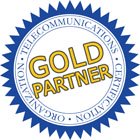Study Guide Notes For This Lesson
These are the words that are displayed and spoken during the lesson. Get these notes for the whole course in the Certification Study Guide, available in print or eBook. Many people tell us a printed companion book enhances their learning!
The OSI Reference Model is referred to as a 7-layer model because the total set of functions required to interwork diverse systems was defined and then broken up into seven groups or layers, and arranged in a hierarchy.
Each layer has a name and a number. We start numbering at the bottom:
1: Physical Layer The physical layer provides a raw bit stream service. It moves 1s and 0s between the systems. This is all it does, but it has to do this completely. The physical layer includes the mechanical, electrical, functional and procedural specifications for moving binary digits over a physical medium.
2: Data Link Layer The data link layer manages communications on a single circuit, a single link. There may be several stations connected to the circuit as is the case with a wireless LAN. This is called a multidrop circuit – but even though there are multiple stations, it is a single physical circuit. Alternatively, there may be just two stations on the link, as is the case with a LAN patch cable. The data link layer performs access control, flow control and error detection on the link, transmitting frames on the physical medium. This allows communications of blocks of data from one device to another on the same circuit.
3: Network Layer The definition of a network is connecting multiple links or circuits with network equipment. Instead of broadcasting data to all stations on all of the circuits, data is routed and relayed from one circuit to the next to eventually be delivered to the correct circuit to which the desired station is attached. A router moves data from one circuit to another, essentially a forwarding function. Knowing which circuit to forward the data on is the routing part of the story. The first three layers form a network, and give the sender the ability to direct data to be delivered to a particular destination.
4. Transport Layer Layer four, the transport layer, implements two major functions. One is reliability. Some network protocols, IP for example, do not provide guaranteed delivery of packets. The transport layer communicates between the source and destination across the network to verify that each packet is successfully received, and in the case of file transfers, retransmits lost packets. The second function performed by the transport layer is to identify the software application that is sending the data, and the software application the data is intended for at the far end. This is indicated by a number called the port number. This allows multiple applications to use the same network connection, for example, an email program and a browser to receive packets over a shared network connection. The port number indicates whether a received packet is for the email application or the browser application. These four layers working together provide a transport service, moving data reliably from one application to another. This is called a socket in the IP / UNIX worlds .
5. Session Layer The session layer manages sessions between applications, including initiation, maintenance and termination of information transfer sessions. Usually this is visible to the user by having to log on with a password in the case of client-server sessions.
6. Presentation Layer The presentation layer is very important: this is the coding step, representing the message to be communicated in 1s and 0s. ASCII is an example of a presentation layer protocol. Compression and encryption also fit into the presentation layer – they are methods of coding messages into 1s and 0s, as are codecs for voice and video digitization.
7. Application Layer Sitting on top of all of this is the application layer. The application layer defines the format of the messages that will be exchanged, and usually implements a Human-Machine Interface.
Using all of this is a person.
The person interacts with the system via the Human-Machine Interface implemented by the application layer, that lets the person create a message.
In turn, the application layer would ask the presentation layer to code it, and then that would ask the session layer to open a session with the far-end piece of software, and in turn ask the transport layer to move it reliably.
The transport layer would ask the network layer to move it to the far-end computer, perhaps on a best-efforts basis, then the network layer will move a packet to the next hop, the next router, by putting the packet in a frame and transmitting the frame one bit at a time on a physical connection like a LAN cable or wireless frequency.















 OSI 7-Layer Reference Model and Protcol Stack Examples
OSI 7-Layer Reference Model and Protcol Stack Examples